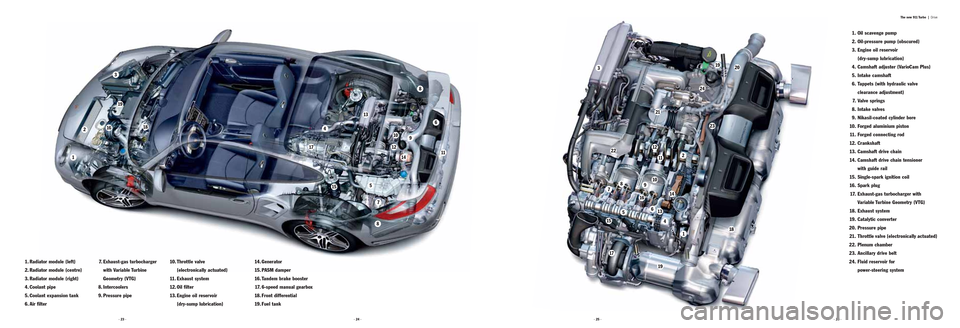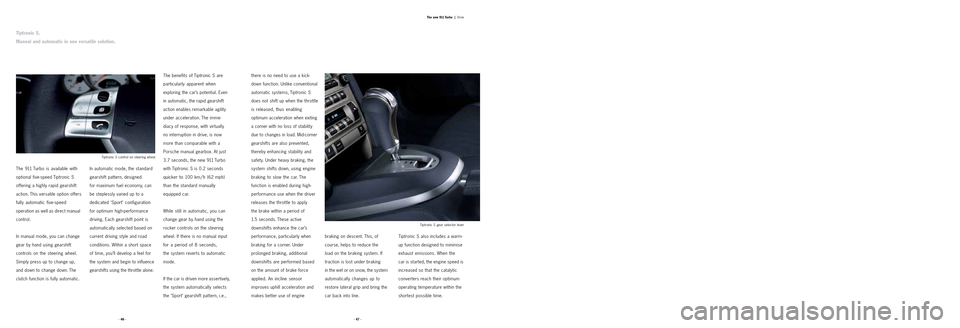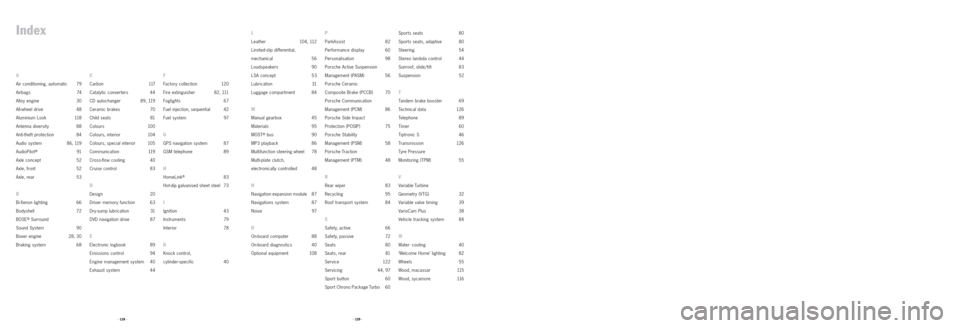catalytic converter PORSCHE 911 TURBO 2004 4.G Information Manual
[x] Cancel search | Manufacturer: PORSCHE, Model Year: 2004, Model line: 911 TURBO, Model: PORSCHE 911 TURBO 2004 4.GPages: 61, PDF Size: 2.14 MB
Page 10 of 61

· 26 ·The new 911 Turbo |
Drive
· 25 · · 24 · · 23 ·
7. Exhaust-gas turbocharger
with Variable Turbine
Geometry (VTG)
8. Intercoolers
9. Pressure pipe
10. Throttle valve
(electronically actuated)
11. Exhaust system
12. Oil filter
13. Engine oil reservoir
(dry-sump lubrication)
1. Radiator module (left)
2. Radiator module (centre)
3. Radiator module (right)
4. Coolant pipe
5. Coolant expansion tank
6. Air filter
14. Generator
15. PASM damper
16. Tandem brake booster
17. 6-speed manual gearbox
18. Front differential
19. Fuel tank1. Oil scavenge pump
2. Oil-pressure pump (obscured)
3. Engine oil reservoir
(dry-sump lubrication)
4. Camshaft adjuster (VarioCam Plus)
5. Intake camshaft
6. Tappets (with hydraulic valve
clearance adjustment)
7. Valve springs
8. Intake valves
9. Nikasil-coated cylinder bore
10. Forged aluminium piston
11. Forged connecting rod
12. Crankshaft
13. Camshaft drive chain
14. Camshaft drive chain tensioner
with guide rail
15. Single-spark ignition coil
16. Spark plug
17. Exhaust-gas turbocharger with
Variable Turbine Geometry (VTG)
18. Exhaust system
19. Catalytic converter
20. Pressure pipe
21. Throttle valve (electronically actuated)
22. Plenum chamber
23. Ancillary drive belt
24. Fluid reservoir for
power-steering system
1
2
3
4
5
21
2019
19
9
6
23
24
16
11
12
14
13
22
15
17
7810
18
16
1
2
6
5
3
109
8
7
15
17
18
19
14
13
12
4
11
8
Page 18 of 61

are reduced thanks to lengthy
replacement intervals for both
the engine oil (18,000 miles) and
air filter unit (36,000 miles). The
spark plugs require changing after
36,000 miles or a maximum of
every four years. The generator,
power-steering pump and air-
conditioning compressor are all
driven by a single self-adjusting
belt with a service life of 54,000
miles. The hydraulic tappets
provide automatic adjustment of
all valve clearances, while the
drive chains on the camshafts
and auxiliary shafts will also last
the life of the car.
Basic servicing is required after
18,000 miles or a maximum of
two years on the road. The first
major service is due at 36,000
miles or every four years at the
latest. The results: lower running
costs and virtually uninterrupted
enjoyment from your Porsche.
Exhaust system.
The exhaust system on the
911 Turbo is made from highly
durable stainless steel. The
system consists of two separate
tracts, one for each bank of
cylinders. The catalytic converters
are extremely heat-resistant,
yet quick to reach temperature
(and thus optimum performance)
when the engine is started
from cold.Twin lambda sensors in each of
the exhausts enable continuous
monitoring of the combustion
process. An additional pair of
sensors* is used to measure
the efficiency of the catalytic
converters.
Servicing.
Another pleasant surprise on the
new 911 Turbo is the standard
service schedule. Running costs
The new six-speed manual
gearbox in the 911 Turbo is
specifically adapted to the car’s
high levels of engine torque.
Designed primarily for sports
driving, one immediate
characteristic is the perfectly
judged spread betweensuccessive ratios as you upshift
through the gears. The gearshift
throw is short and precise,
with only minimal force required.
Thanks to a dual-mass flywheel,
this uncompromising setup means
there’s never any compromise
in comfort. The linkage provides
a direct connection with the
gearbox while insulating
the lever from engine vibration.
One final detail – the new gear
lever design – is exclusive to
the 911 Turbo.
· 44 ·· 45 ·The new 911 Turbo |
Drive
Six-speed manual gearbox.
Superlative power requires equal precision.
Gear lever exclusive to 911 Turbo* Not in markets with leaded fuel.
Page 19 of 61

Tiptronic S also includes a warm-
up function designed to minimise
exhaust emissions. When the
car is started, the engine speed is
increased so that the catalytic
converters reach their optimum
operating temperature within the
shortest possible time. braking on descent. This, of
course, helps to reduce the
load on the braking system. If
traction is lost under braking
in the wet or on snow, the system
automatically changes up to
restore lateral grip and bring the
car back into line. there is no need to use a kick-
down function. Unlike conventional
automatic systems, Tiptronic S
does not shift up when the throttle
is released, thus enabling
optimum acceleration when exiting
a corner with no loss of stability
due to changes in load. Mid-corner
gearshifts are also prevented,
thereby enhancing stability and
safety. Under heavy braking, the
system shifts down, using engine
braking to slow the car. The
function is enabled during high-
performance use when the driver
releases the throttle to apply
the brake within a period of
1.5 seconds. These active
downshifts enhance the car’s
performance, particularly when
braking for a corner. Under
prolonged braking, additional
downshifts are performed based
on the amount of brake force
applied. An incline sensor
improves uphill acceleration and
makes better use of engine
The 911 Turbo is available with
optional five-speed Tiptronic S
offering a highly rapid gearshift
action. This versatile option offers
fully automatic five-speed
operation as well as direct manual
control.
In manual mode, you can change
gear by hand using gearshift
controls on the steering wheel.
Simply press up to change up,
and down to change down. The
clutch function is fully automatic.In automatic mode, the standard
gearshift pattern, designed
for maximum fuel economy, can
be steplessly varied up to a
dedicated ‘Sport’ configuration
for optimum high-performance
driving. Each gearshift point is
automatically selected based on
current driving style and road
conditions. Within a short space
of time, you’ll develop a feel for
the system and begin to influence
gearshifts using the throttle alone.
The benefits of Tiptronic S are
particularly apparent when
exploring the car’s potential. Even
in automatic, the rapid gearshift
action enables remarkable agility
under acceleration. The imme-
diacy of response, with virtually
no interruption in drive, is now
more than comparable with a
Porsche manual gearbox. At just
3.7 seconds, the new 911 Turbo
with Tiptronic S is 0.2 seconds
quicker to 100 km / h (62 mph)
than the standard manually
equipped car.
While still in automatic, you can
change gear by hand using the
rocker controls on the steering
wheel. If there is no manual input
for a period of 8 seconds,
the system reverts to automatic
mode.
If the car is driven more assertively,
the system automatically selects
the ‘Sport’ gearshift pattern, i.e.,
· 46 ·· 47 ·The new 911 Turbo |
Drive
Tiptronic S gear selector lever Tiptronic S control on steering wheel
Tiptronic S.
Manual and automatic in one versatile solution.
Page 43 of 61

At Porsche, we’re exploring every
possibility to improve the environ-
mental compatibility of our cars:
modern materials, reduced fuel
consumption, cleaner emissions,
fewer pollutants and better
recyclability. This commitment is a
Porsche tradition that began in
the 1960s. With the latest evolutionof the 911 Turbo, the rewards are
even greater than ever.
Exhaust emission control.
Combine engineering expertise
with a commitment to the
environment and the resulting
benefits are twofold: exceptional
performance and lower emissions.
One of the cleanest sportscars
in the world today, the new
911 Turbo easily complies with
both the stringent Euro 4 standard
in the European Union as well
as LEV II regulations in the United
States.The technologies used to achieve
this compliance include twin
‘lambda’ or oxygen sensors for
each of the two cylinder banks.
One pair of sensors is used to
measure the levels of oxygen in
each of the twin exhaust tracts.
An additional pair of sensors –
again, one in each tract – enablethe engine management system
to monitor the efficiency of the
catalytic converters.*
Recycling.
Lightweight construction, long-
term durability, exceptional
recyclability: just three of the
techniques employed by Porsche
to improve the environmental
compatibility of our cars.
On the new 911 Turbo, we’ve
used weight-saving design and
lightweight materials to achieve
excellent fuel economy.
All materials and manufacturing
processes have been carefully
selected and specifically refined
to reduce any impact on the
environment. A prime example is
the twin exhaust system, which is
made entirely from stainless steel.
All lightweight materials are easily
recyclable, while the variety ofsynthetics has been significantly
reduced. Recycled plastics are
used in every area of the car
where our exacting specifications
allow. To simplify processing, all
materials are labelled for separate
recycling. Approximately 85 % of
today’s 911 Turbo is compatible
with current recycling techniques.
Water-based paints are used
throughout the car, thus reducing
the need for chemical solvents in
both production and subsequent
servicing. Other harmful materials
omitted from the vehicle include
asbestos, CFCs, and components
manufactured using CFCs.
The result is a car in which
environmental protection is an
integral part of the overall design.
· 94 ·· 95 ·The new 911 Turbo |
Environment
* Not in markets with leaded fuel.
The 911 Turbo is dedicated to performance.
Also with respect to the environment.
Page 59 of 61

L
Leather 104, 112
Limited-slip differential,
mechanical 56
Loudspeakers 90
LSA concept 53
Lubrication 31
Luggage compartment 84
M
Manual gearbox 45
Materials 95
MOST
®bus 90
MP3 playback 86
Multifunction steering wheel 78
Multi-plate clutch,
electronically controlled 48
N
Navigation expansion module 87
Navigations system 87
Noise 97
O
On-board computer 88
On-board diagnostics 40
Optional equipment 108
P
ParkAssist 82
Performance display 60
Personalisation 98
Porsche Active Suspension
Management (PASM) 56
Porsche Ceramic
Composite Brake (PCCB) 70
Porsche Communication
Management (PCM) 86
Porsche Side Impact
Protection (POSIP) 75
Porsche Stability
Management (PSM) 58
Porsche Traction
Management (PTM) 48
R
Rear wiper 83
Recycling 95
Roof transport system 84
S
Safety, active 66
Safety, passive 72
Seats 80
Seats, rear 81
Service 122
Servicing 44, 97
Sport button 60
Sport Chrono Package Turbo 60Sports seats 80
Sports seats, adaptive 80
Steering 54
Stereo lambda control 44
Sunroof, slide/tilt 83
Suspension 52
T
Tandem brake booster 69
Technical data 126
Telephone 89
Timer 60
Tiptronic S 46
Transmission 126
Tyre Pressure
Monitoring (TPM) 55
V
Variable Turbine
Geometry (VTG) 32
Variable valve timing 39
VarioCam Plus 38
Vehicle tracking system 84
W
Water- cooling 40
‘Welcome Home’ lighting 82
Wheels 55
Wood, macassar 115
Wood, sycamore 116
· 129 ·
A
Air conditioning, automatic 79
Airbags 74
Alloy engine 30
All-wheel drive 48
Aluminium Look 118
Antenna diversity 88
Anti-theft protection 84
Audio system 86, 119
AudioPilot
®91
Axle concept 52
Axle, front 52
Axle, rear 53
B
Bi-Xenon lighting 66
Bodyshell 72
BOSE
®Surround
Sound System 90
Boxer engine 28, 30
Braking system 68
C
Carbon 117
Catalytic converters 44
CD autochanger 89, 119
Ceramic brakes 70
Child seats 81
Colours 100
Colours, interior 104
Colours, special interior 105
Communication 119
Cross-flow cooling 40
Cruise control 83
D
Design 20
Driver memory function 63
Dry-sump lubrication 31
DVD navigation drive 87
E
Electronic logbook 89
Emissions control 94
Engine management system 40
Exhaust system 44
F
Factory collection 120
Fire extinguisher 82, 111
Foglights 67
Fuel injection, sequential 42
Fuel system 97
G
GPS navigation system 87
GSM telephone 89
H
HomeLink®83
Hot-dip galvanised sheet steel 73
I
Ignition 43
Instruments 79
Interior 78
K
Knock control,
cylinder-specific 40
· 128 ·
Index